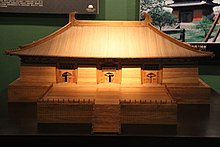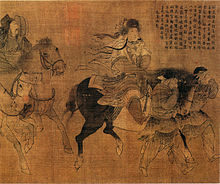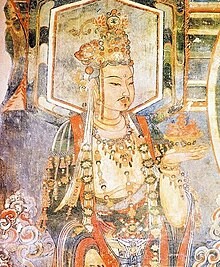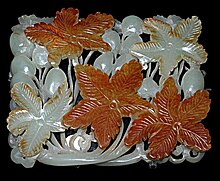Jin dynasty (1115–1234)
Great Jin | |||||||||||||||||||||
|---|---|---|---|---|---|---|---|---|---|---|---|---|---|---|---|---|---|---|---|---|---|
| 1115–1234 | |||||||||||||||||||||
 Location of Jin dynasty (blue ) c. 1141
| |||||||||||||||||||||
 Circuits of Jin | |||||||||||||||||||||
| Capital | |||||||||||||||||||||
| Common languages | Middle Chinese (later Old Mandarin), Jurchen, Khitan | ||||||||||||||||||||
| Religion | |||||||||||||||||||||
| Government | Monarchy | ||||||||||||||||||||
Emperor | |||||||||||||||||||||
• 1115–1123 | Taizu (first) | ||||||||||||||||||||
• 1161–1189 | Shizong | ||||||||||||||||||||
• 1234 | Modi (last) | ||||||||||||||||||||
| Historical era | Northern Song dynasty | 9 January 1127 | |||||||||||||||||||
• Mongol invasion | 1211 | ||||||||||||||||||||
| 9 February 1234 | |||||||||||||||||||||
| Area | |||||||||||||||||||||
| 1142 est. | 3,610,000 km2 (1,390,000 sq mi) | ||||||||||||||||||||
| 1186 est. | 4,750,000 km2 (1,830,000 sq mi) | ||||||||||||||||||||
| Population | |||||||||||||||||||||
• 1186 est.[1] | 53,000,000 | ||||||||||||||||||||
| Currency |
| ||||||||||||||||||||
| |||||||||||||||||||||
| Today part of | |||||||||||||||||||||
| Part of a series on the |
| History of China |
|---|
The Jin dynasty (/dʒɪn/,[2] [tɕín]; Chinese: 金朝; pinyin: Jīn cháo),[a] officially known as the Great Jin (大金; Dà Jīn), was an imperial dynasty of China that existed between 1115 and 1234.[b] Because the Wanyan clan that founded the dynasty were of Jurchen descent, it is also sometimes called the Jurchen dynasty or the Jurchen Jin.
The Jin dynasty emerged from
After spending centuries in vassalage under the Jin, the Mongols under Genghis Khan invaded in 1211, inflicting several crushing defeats upon Jin armies. After a sequence of defeats, revolts, defections, and coups over a span of 23 years, the Jin were ultimately conquered by the Mongols in 1234.
Name
The Jin dynasty was officially known as the "Great Jin" at that time. Furthermore, the Jin emperors referred to their state as China, Zhongguo (中國), just as some other non-Han dynasties.[6] Non-Han rulers expanded the definition of "China" to include non-Han peoples in addition to Han people whenever they ruled China.[7] Jin documents indicate that the usage of "China" by dynasties to refer to themselves began earlier than previously thought.[8]
History
| Jin dynasty | |
|---|---|
| Chinese name | |
Hanyu Pinyin | Dà Jīn |
| Bopomofo | ㄉㄚˋ ㄐㄧㄣ |
| Wade–Giles | Ta4 Chin1 |
| Tongyong Pinyin | Dà Jin |
| IPA | [tâ.tɕín] |
| Yue: Cantonese | |
| Jyutping | daai6 gam1 |
| IPA | [taːi˨ kɐm˥] |
Origin
The Mohe were the ancestors of the Jin. the Mohe were called Wuji, the Wuji lived on the land of the Sushen people. There are seven Wuji tribes: Sumo, Boduo, Anchegu, Funie, Haoshi, Heishui, Baishan.
The progenitors of the
The two most powerful groups of Mohe were the
In the 11th century there was widespread discontent against
Wanyan Aguda
The Jin dynasty was created in modern
Having conquered Kaifeng and occupied northern China, the Jin later deliberately chose earth as its dynastic element and yellow as its royal color. According to the theory of the wuxing ('five elements'), the earth element follows the fire, the dynastic element of the Song, in the sequence of elemental creation. Therefore, this ideological move shows that the Jin regarded the Song reign of China was officially over and themselves as the rightful ruler of China Proper.[23]
Migration south
After taking over northern China, the Jin became increasingly
Following the death of Emperor Taizong in 1135, each of the next three emperors were the remaining grandsons of Aguda, each by a different one of his sons. Emperor Xizong (r. 1135–1149) studied the classics and wrote Chinese poetry. He adopted Han Chinese cultural traditions, but the Jurchen nobles had the top positions. Later in life, Emperor Xizong became an alcoholic and executed many officials for criticising him. He also had Jurchen leaders who opposed him murdered, even those in the Wanyan clan. In 1149 he was murdered by a cabal of relatives and nobles, who made his cousin Wanyan Liang the next Jin emperor. Because of the brutality of both his domestic and foreign policy, Wanyan Liang was posthumously demoted from the position of emperor. Historians have consequently referred to him by his posthumous name "Prince of Hailing".[25]
Rebellions in the north
Having usurped the throne,
Wanyan Liang also tried to suppress dissent by killing Jurchen nobles, executing 155 princes.


Although crowned in October, Wanyan Yong (Emperor Shizong) was not officially recognised as emperor until the murder of Wanyan Liang's heir.[25] The Khitan uprising was not suppressed until 1164; their horses were confiscated so that the rebels had to take up farming. Other Khitan and Xi cavalry units had been incorporated into the Jin army. Because these internal uprisings had severely weakened the Jin's capacity to confront the Southern Song militarily, the Jin court under Emperor Shizong began negotiating for peace. The Treaty of Longxing was signed in 1164, ushering in more than 40 years of peace between the two empires.
In the early 1180s, Emperor Shizong instituted a restructuring of 200 meng'an units to remove tax abuses and help Jurchens. Communal farming was encouraged. The Jin Empire prospered and had a large surplus of grain in reserve. Although learned in
Shizong's grandson, Emperor Zhangzong (r. 1189–1208), venerated Jurchen values, but he also immersed himself in Han Chinese culture and married an ethnic Han Chinese woman. The Taihe Code of law was promulgated in 1201 and was based mostly on the Tang Code. In 1207, the Southern Song dynasty attempted an invasion, but the Jin forces effectively repulsed them. In the peace agreement, the Song dynasty had to pay higher annual indemnities and behead Han Tuozhou, the leader of the hawkish faction in the Song imperial court.
Fall of Jin
Starting from the early 13th century, the Jin dynasty began to feel the pressure of Mongols from the north. Genghis Khan first led the Mongols into Western Xia territory in 1205 and ravaged it four years later. In 1211 about 50,000 Mongol horsemen invaded the Jin Empire and began absorbing Khitan and Jurchen rebels. The Jin had a large army with 150,000 cavalry but abandoned the "western capital" Datong (see also the Battle of Yehuling). The next year the Mongols went north and looted the Jin "eastern capital", and in 1213 they besieged the "central capital", Zhongdu (present-day Beijing). In 1214 the Jin made a humiliating treaty but retained the capital. That summer, Emperor Xuanzong abandoned the central capital and moved the government to the "southern capital" Kaifeng, making it the official seat of the Jin dynasty's power.
In 1216, a hawkish faction in the Jin imperial court persuaded Emperor Xuanzong to attack the Song dynasty, but in 1219 they were defeated at the same place by the
The Jurchen Jin emperor Wanyan Yongji's daughter, Jurchen Princess Qiguo was married to Mongol leader Genghis Khan in exchange for relieving the Mongol siege of Zhongdu in the Mongol conquest of the Jin dynasty.[29]

Many
Shi Tianze was a Han Chinese who lived under Jin rule. Inter-ethnic marriage between Han Chinese and Jurchens became common at this time. His father was Shi Bingzhi. Shi Bingzhi married a Jurchen woman (surname Nahe) and a Han Chinese woman (surname Zhang); it is unknown which of them was Shi Tianze's mother.[38] Shi Tianze was married to two Jurchen women, a Han Chinese woman, and a Korean woman, and his son Shi Gang was born to one of his Jurchen wives.[39] His Jurchen wives' surnames were Monian and Nahe, his Korean wife's surname was Li, and his Han Chinese wife's surname was Shi.[38] Shi Tianze defected to the Mongol forces upon their invasion of the Jin dynasty. His son, Shi Gang, married a Keraite woman; the Keraites were Mongolified Turkic people and considered as part of the "Mongol nation".[39][40] Shi Tianze, Zhang Rou, Yan Shi and other Han Chinese who served in the Jin dynasty and defected to the Mongols helped build the structure for the administration of the new Mongol state.[41]
The Mongols created a Han army out of defecting Jin troops, and another army out of defected Song troops called the "Newly Submitted Army" (新附軍).[42]
Genghis Khan died in 1227 while his armies were attacking Western Xia. His successor, Ögedei Khan, invaded the Jin dynasty again in 1232 with assistance from the
Government
The government of the Jin dynasty merged Jurchen customs with institutions adopted from the Liao and Song dynasties.[43] The pre-dynastic Jurchen government was based on the quasi-egalitarian tribal council.[44] Jurchen society at the time did not have a strong political hierarchy. The Shuo Fu (說郛) records that the Jurchen tribes were not ruled by central authority and locally elected their chieftains.[43] Tribal customs were retained after Aguda united the Jurchen tribes and formed the Jin dynasty, coexisting alongside more centralised institutions.[45] The Jin dynasty had five capitals, a practice they adopted from the Balhae and the Liao.[46] The Jin had to overcome the difficulties of controlling a multicultural empire composed of territories once ruled by the Liao and Northern Song. The solution of the early Jin government was to establish separate government structures for different ethnic groups.[47]
The Jin court maintained a clear separation between the sedentary population who had lived under Liao rule, and the sedentary population who formerly lived under Northern Song rule but had never been under Liao rule. The former they referred to as hanren or yanren while the latter they referred to as nanren.[48]
Culture
Because the Jin had few contacts with its southern neighbour, the Song dynasty, different cultural developments took place in both states. Within Confucianism, the "Learning of the Way" that developed and became orthodox in Song did not take root in Jin. Jin scholars put more emphasis on the work of northern Song scholar and poet Su Shi (1037–1101) than on Zhu Xi's (1130–1200) scholarship, which constituted the foundation of the Learning of the Way.[49]
Architecture
The Jin pursued a revival of Tang dynasty urban design with architectural projects in Kaifeng and Zhongdu (modern Beijing), building for instance a bell tower and drum tower to announce the night curfew (which was revived after being abolished under the Song).[50] The Jurchens followed Khitan precedent of living in tents amidst the Chinese-style architecture, which were in turn based on the Song dynasty Kaifeng model.[51]
Religion

Taoism
This section may require copy editing. (March 2024) |
A significant branch of



The Jin state sponsored an edition of the
Buddhism
A
Buddhism thrived during the Jin, both in its relation with the imperial court and in society in general.
Fashion
List of emperors
| Temple name | Posthumous name1 | Jurchen name | Chinese name | Years of reign | Era names and years |
|---|---|---|---|---|---|
| Taizu (太祖) | Wuyuan (武元) | Aguda (阿骨打) | Min (旻) | 1115–1123 | Shouguo (收國; 1115–1116) Tianfu (天輔; 1117–1123) |
| Taizong (太宗) | Wenlie (文烈) | Wuqimai (吳乞買) | Sheng (晟) | 1123–1135 | Tianhui (天會; 1123–1135) |
| Xizong (熙宗) | Xiaocheng (孝成) | Hela (合剌) | Dan (亶) | 1135–1149 | Tianhui (天會; 1135–1138) Tianjuan (天眷; 1138–1141) Huangtong (皇統; 1141–1149) |
| None | – | Digunai (迪古乃) | Liang (亮) | 1149–1161 | Tiande (天德, 1149–1153) Zhenyuan (貞元; 1153–1156) Zhenglong (正隆; 1156–1161) |
| Shizong (世宗) | Renxiao (仁孝) | Wulu (烏祿) | Yong (雍) | 1161–1189 | Dading (大定; 1161–1189) |
| Zhangzong 章宗 |
Guangxiao (光孝) | Madage (麻達葛) | Jing (璟) | 1189–1208 | Mingchang (明昌; 1190–1196) Cheng'an (承安; 1196–1200) Taihe (泰和; 1200–1208) |
| None | – | Unknown | Yongji (永濟) | 1208–1213 | Da'an (大安; 1209–1212) Chongqing (崇慶; 1212–1213) Zhining (至寧; 1213) |
| Xuanzong 宣宗 |
Shengxiao (聖孝) | Wudubu (吾睹補) | Xun (珣) | 1213–1224 | Zhenyou (貞祐; 1213–1217) Xingding (興定; 1217–1222) Yuanguang (元光; 1222–1224) |
| Aizong (哀宗, official) Zhuangzong (莊宗, unofficial) Minzong (閔宗, unofficial) Yizong (義宗, unofficial) |
None | Ningjiasu (寧甲速) | Shouxu (守緒) | 1224–1234 | Zhengda (正大; 1224–1232) Kaixing (開興; 1232) Tianxing (天興; 1232–1234) |
| None | None | Hudun (呼敦) | Chenglin (承麟) | 1234 | Shengchang (盛昌; 1234) |
| 1: For full posthumous names, see the articles for individual emperors. | |||||
Emperors family tree
| Emperors family tree | |||||||||||||||||||||||||||||||||||||||||||||||||||||||||||||||||||||||||||||||||||||||||||||||||||||||||||||||||||||||||||||||||||||||||||||||||||||||||||||||||||||||||||||||||||||||||||||||||||||||||||||||||||||||||||||||||||||||||||||||||||||||||||||||||||||||||||||||||||||||||||||||||||||||||||||||||||||||||||||||||||||||||||||||||||||||||||||||||||||||||||||||||||||||||||||||||||||||||||||||||||||||||||||||||||||||||||||||||||||||||||||||||||||||||||||||||||||||||||||||||||||||||||||||||||||||||||||||||||||||||||||||||||||||||||||||||||||||||||||||||||||||||||||||||||||||||||||||||||||||||||||||||||||||||||||||||||||||||||||||||||||||||||||||||||||||||||||||||||||||||||||||||||||||||||||||||||||||||||||||||||||||||||||||||||||||||||||||||||||||||||||||||||||||||||||||||||||||||||||||||||||||||||||||||||||||||||||||||||||||||||||||||||||||||||||||||||||||||||||||||||||||||||||||||||||||||||||||||||||||||||||||||||||||||||||||||||||||||||||||||||||||||||||||||||||||||||||||||||||||
|---|---|---|---|---|---|---|---|---|---|---|---|---|---|---|---|---|---|---|---|---|---|---|---|---|---|---|---|---|---|---|---|---|---|---|---|---|---|---|---|---|---|---|---|---|---|---|---|---|---|---|---|---|---|---|---|---|---|---|---|---|---|---|---|---|---|---|---|---|---|---|---|---|---|---|---|---|---|---|---|---|---|---|---|---|---|---|---|---|---|---|---|---|---|---|---|---|---|---|---|---|---|---|---|---|---|---|---|---|---|---|---|---|---|---|---|---|---|---|---|---|---|---|---|---|---|---|---|---|---|---|---|---|---|---|---|---|---|---|---|---|---|---|---|---|---|---|---|---|---|---|---|---|---|---|---|---|---|---|---|---|---|---|---|---|---|---|---|---|---|---|---|---|---|---|---|---|---|---|---|---|---|---|---|---|---|---|---|---|---|---|---|---|---|---|---|---|---|---|---|---|---|---|---|---|---|---|---|---|---|---|---|---|---|---|---|---|---|---|---|---|---|---|---|---|---|---|---|---|---|---|---|---|---|---|---|---|---|---|---|---|---|---|---|---|---|---|---|---|---|---|---|---|---|---|---|---|---|---|---|---|---|---|---|---|---|---|---|---|---|---|---|---|---|---|---|---|---|---|---|---|---|---|---|---|---|---|---|---|---|---|---|---|---|---|---|---|---|---|---|---|---|---|---|---|---|---|---|---|---|---|---|---|---|---|---|---|---|---|---|---|---|---|---|---|---|---|---|---|---|---|---|---|---|---|---|---|---|---|---|---|---|---|---|---|---|---|---|---|---|---|---|---|---|---|---|---|---|---|---|---|---|---|---|---|---|---|---|---|---|---|---|---|---|---|---|---|---|---|---|---|---|---|---|---|---|---|---|---|---|---|---|---|---|---|---|---|---|---|---|---|---|---|---|---|---|---|---|---|---|---|---|---|---|---|---|---|---|---|---|---|---|---|---|---|---|---|---|---|---|---|---|---|---|---|---|---|---|---|---|---|---|---|---|---|---|---|---|---|---|---|---|---|---|---|---|---|---|---|---|---|---|---|---|---|---|---|---|---|---|---|---|---|---|---|---|---|---|---|---|---|---|---|---|---|---|---|---|---|---|---|---|---|---|---|---|---|---|---|---|---|---|---|---|---|---|---|---|---|---|---|---|---|---|---|---|---|---|---|---|---|---|---|---|---|---|---|---|---|---|---|---|---|---|---|---|---|---|---|---|---|---|---|---|---|---|---|---|---|---|---|---|---|---|---|---|---|---|---|---|---|---|---|---|---|---|---|---|---|---|---|---|---|---|---|---|---|---|---|---|---|---|---|---|---|---|---|---|---|---|---|---|---|---|---|---|---|---|---|---|---|---|---|---|---|---|---|---|---|---|---|---|---|---|---|---|---|---|---|---|---|---|---|---|---|---|---|---|---|---|---|---|---|---|---|---|---|---|---|---|---|---|---|---|---|---|---|---|---|---|---|---|---|---|---|---|---|---|---|---|---|---|---|---|---|---|---|---|---|---|---|---|---|---|---|---|---|---|---|---|---|---|---|---|---|---|---|---|---|---|---|---|---|---|---|---|---|---|---|---|---|---|---|---|---|---|---|---|---|---|---|---|---|---|---|---|---|---|---|---|---|---|---|---|---|---|---|---|---|---|---|---|---|---|---|---|---|---|---|---|---|---|---|---|---|---|---|---|---|---|---|---|---|---|---|---|---|---|---|---|---|---|---|---|---|---|---|---|---|---|---|---|---|---|---|---|---|---|---|---|---|---|---|---|---|---|---|---|---|---|---|---|---|---|---|---|---|---|---|---|---|---|---|---|---|---|---|---|---|---|---|---|---|---|---|---|---|---|---|---|---|---|---|---|---|---|---|---|---|---|---|---|---|---|---|---|---|---|---|---|---|---|---|---|---|---|---|---|---|---|---|---|---|---|---|---|---|---|---|---|---|---|---|---|---|---|---|---|---|---|---|---|---|---|---|---|---|---|---|---|---|---|---|---|---|---|---|---|---|---|---|---|---|---|---|---|---|---|---|---|---|---|---|---|---|---|---|---|---|---|---|---|---|---|---|---|---|---|---|---|---|---|---|---|---|---|---|---|---|---|---|---|---|---|---|---|---|---|---|---|---|---|---|---|---|---|---|---|---|---|---|---|---|---|---|---|---|---|---|---|---|---|---|---|---|---|---|---|---|---|---|---|---|---|---|---|---|---|---|---|---|---|---|---|---|---|---|---|---|---|---|---|---|---|---|---|---|---|---|---|
| |||||||||||||||||||||||||||||||||||||||||||||||||||||||||||||||||||||||||||||||||||||||||||||||||||||||||||||||||||||||||||||||||||||||||||||||||||||||||||||||||||||||||||||||||||||||||||||||||||||||||||||||||||||||||||||||||||||||||||||||||||||||||||||||||||||||||||||||||||||||||||||||||||||||||||||||||||||||||||||||||||||||||||||||||||||||||||||||||||||||||||||||||||||||||||||||||||||||||||||||||||||||||||||||||||||||||||||||||||||||||||||||||||||||||||||||||||||||||||||||||||||||||||||||||||||||||||||||||||||||||||||||||||||||||||||||||||||||||||||||||||||||||||||||||||||||||||||||||||||||||||||||||||||||||||||||||||||||||||||||||||||||||||||||||||||||||||||||||||||||||||||||||||||||||||||||||||||||||||||||||||||||||||||||||||||||||||||||||||||||||||||||||||||||||||||||||||||||||||||||||||||||||||||||||||||||||||||||||||||||||||||||||||||||||||||||||||||||||||||||||||||||||||||||||||||||||||||||||||||||||||||||||||||||||||||||||||||||||||||||||||||||||||||||||||||||||||||||||||||||
See also
| History of Manchuria |
|---|
 |
- Eastern Xia
- Jurchen Jin emperors family tree
- Korean–Jurchen border conflicts
- Timeline of the Jin–Song Wars
Notes
References
Citations
- ^ Twitchett & Fairbank 1994, p. 40.
- ^ "Jin". Random House Webster's Unabridged Dictionary.
- ISBN 978-0-8135-1304-1
- ^ Franke 1994b, pp. 215–320.
- ISBN 978-0-595-12578-4, retrieved 28 June 2014
- ^ Zhao 2006, p. 7.
- ^ Zhao 2006, p. 6.
- ^ Zhao 2006, p. 24.
- ^ Gorelova 2002, pp. 13–14.
- ^ Crossley 1997, p. 17.
- ^ Crossley 1997, p. 124.
- ^ Crossley 1997, p. 18–20.
- ^ Franke 1994b, p. 217–220.
- ^ Breuker 2010, pp. 220–221.
- ^ Franke 1994b, p. 220.
- ^ a b Franke 1994b, p. 221.
- ^ Franke 1994a, p. 39.
- ^ Tillman 1995a, pp. 28–.
- ^ Elliott, Mark (2012), "8. Hushuo The Northern Other and the Naming of the Han Chinese" (PDF), in Mullaney, Tomhas S.; Leibold, James; Gros, Stéphane; Bussche, Eric Vanden (eds.), Critical Han Studies The History, Representation, and Identity of China's Majority, University of California Press, p. 186
- ^ Gernet 1996, pp. 358–.
- ISBN 978-0-231-11004-4
- ^ Mark C. Elliot (2001), The Manchu Way: The eight banners and ethnic identity in late imperial China, Stanford University Press, p. 60
- ^ a b c d e f g h Beck, Sanderson, "Liao, Xi Xia, and Jin Dynasties 907–1234", China 7 BC To 1279
- ^ a b Tao (1976), p. 44
- ^ Tao (1976), Chapter 6. "The Jurchen Movement for Revival", pp. 69–83
- S2CID 162237648, retrieved 31 March 2023 – via JSTOR
- ISBN 978-1-108-63662-9.
- ^ Collectif (2002). Revue bibliographique de sinologie 2001. Éditions de l'École des hautes études en sciences sociales. p. 147.
- ^ May, Timothy Michael (2004). The Mechanics of Conquest and Governance: The Rise and Expansion of the Mongol Empire, 1185–1265. University of Wisconsin–Madison. p. 50.
- ^ Schram, Stuart Reynolds (1987). Foundations and Limits of State Power in China. European Science Foundation by School of Oriental and African Studies, University of London. p. 130.
- ^ Gary Seaman; Daniel Marks (1991). Rulers from the steppe: state formation on the Eurasian periphery. Ethnographics Press, Center for Visual Anthropology, University of Southern California. p. 175.
- from the original on 2 August 2016. Retrieved 3 May 2016.
- ^ "窝阔台汗己丑年汉军万户萧札剌考辨–兼论金元之际的汉地七万户-国家哲学社会科学学术期刊数据库". Archived from the original on 13 April 2020. Retrieved 3 May 2016.
- ^ "新元史/卷146 – 維基文庫,自由的圖書館". zh.wikisource.org.
- ^ "作品相关 第二十九章 大库里台. 本章出自《草原特种兵》" [Chapter 29 Big Curry Terrace. This chapter is from Grassland Special Forces] (in Chinese). Archived from the original on 4 March 2016. Retrieved 3 May 2016.
- ^ a b Igor de Rachewiltz, ed. (1993). In the Service of the Khan: Eminent Personalities of the Early Mongol-Yüan Period (1200–1300). Otto Harrassowitz Verlag. p. 41.
- ^ a b J. Ganim; S. Legassie, eds. (2013). Cosmopolitanism and the Middle Ages. Springer. p. 47.
- ^ Watt, James C. Y. (2010). The World of Khubilai Khan: Chinese Art in the Yuan Dynasty. Metropolitan Museum of Art. p. 14.
- S2CID 161851226.
- ^ Hucker, Charles O. (1985). A Dictionary of Official Titles in Imperial China. Stanford University Press. p. 66.
- ^ a b Franke 1994b, p. 265.
- ^ Franke 1994b, pp. 265–266.
- ^ Franke 1994b, p. 266.
- ^ Franke 1994b, p. 270.
- ^ Franke 1994b, p. 267.
- ISBN 9780520289758.)
{{cite book}}: CS1 maint: multiple names: authors list (link - ^ Tillman 1995b, pp. [, page needed], .
- ISBN 978-0-226-57158-4
- ISBN 978-1-107-19642-1
- ^ a b c d Boltz 2008, p. 291.
- ^ Boltz 2008, pp. 291–92.
- ^ a b Boltz 2008, p. 292.
- ^ Yao 1995, p. 174; Goossaert 2008, p. 916 (both Buddhist Canon and Daoist Canon printed in Shanxi).
- ^ a b c Yao 1995, p. 174.
- ^ Yao 1995, p. 173.
- ^ a b c Yao 1995, p. 175.
- ^ a b Yao 1995, p. 161.
- ^ Yao 1995, pp. 161–62.
Sources
- Boltz, Judith (2008), "Da Jin Xuandu baozang 大金玄嘟寶藏", in Pregadio, Fabrizio (ed.), The Encyclopedia of Taoism, London: Routledge, pp. 291–292, ISBN 978-0-7007-1200-7.
- Breuker, Remco E. (2010), Establishing a Pluralist Society in Medieval Korea, 918-1170: History, Ideology and Identity in the Koryŏ Dynasty, Korean Studies Library, vol. 1, Leiden: Brill, pp. 220-221, ISBN 978-9-004-18325-4
- Crossley, Pamela Kyle (2002) [1997], The Manchus, Oxford: Blackwell, ISBN 978-0-631-23591-0}
- Twitchett, Denis C.; Fairbank, John King, eds. (1994), The Cambridge History of China: Alien Regimes and Border States 907–1368, vol. 6, Cambridge University Press, ISBN 978-0-521-24331-5, retrieved 10 March 2014
- Franke, Herbert (1994a). Introduction. In Twitchett & Fairbank (1994), pp. 1–42.
- Franke, Herbert (1994b). "The Chin dynasty". In Twitchett & Fairbank (1994).
- Gernet, Jacques (1996), A History of Chinese Civilization (2nd ed.), Cambridge University Press, ISBN 978-0-521-49781-7
- Goossaert, Vincent (2008), "Song Defang 宋德方", in Pregadio, Fabrizio (ed.), The Encyclopedia of Taoism, London: Routledge, pp. 915–16, ISBN 978-0-700-71200-7.
- Gorelova, Liliya M., ed. (2002), Manchu Grammar, Part 8, Handbook of Oriental Studies, vol. 7, Brill, pp. 13–14, ISBN 9-004-12307-5
- Tao, Jing-shen (1976), The Jurchen in Twelfth-Century China, University of Washington Press, ISBN 978-0-295-95514-8
- Tillman, Hoyt Cleveland; West, Stephen H., eds. (1995), China Under Jurchen Rule: Essays on Chin Intellectual and Cultural History, SUNY Press, ISBN 978-0-791-42273-1
- Tillman, Hoyt Cleveland (1995a). "An Overview of Chin History and Institutions". In Tillman & West (1995), pp. 23–38.
- Tillman, Hoyt Cleveland (1995b). "Confucianism under the Chin and the Impact of Sung Confucian Tao-hsüeh". In Tillman & West (1995), pp. 71–114.
- Yao, Tao-chung. "Buddhism and Taoism under the Chin". In Tillman & West (1995), pp. 145–180.
- Zhao, Gang (2006), "Reinventing China: Imperial Qing Ideology and the Rise of Modern Chinese National Identity in the Early Twentieth Century", Modern China, 32 (1): 3–30, S2CID 144587815
Further reading
- Franke, Herbert (1971), "Chin Dynastic History Project", JSTOR 23497078.
- Schneider, Julia (2011), "The Jin Revisited: New Assessment of Jurchen Emperors", S2CID 162237648
External links
 Media related to Jin Dynasty (1115–1234) at Wikimedia Commons
Media related to Jin Dynasty (1115–1234) at Wikimedia Commons
